Australia Kitchen Appliances Market Size
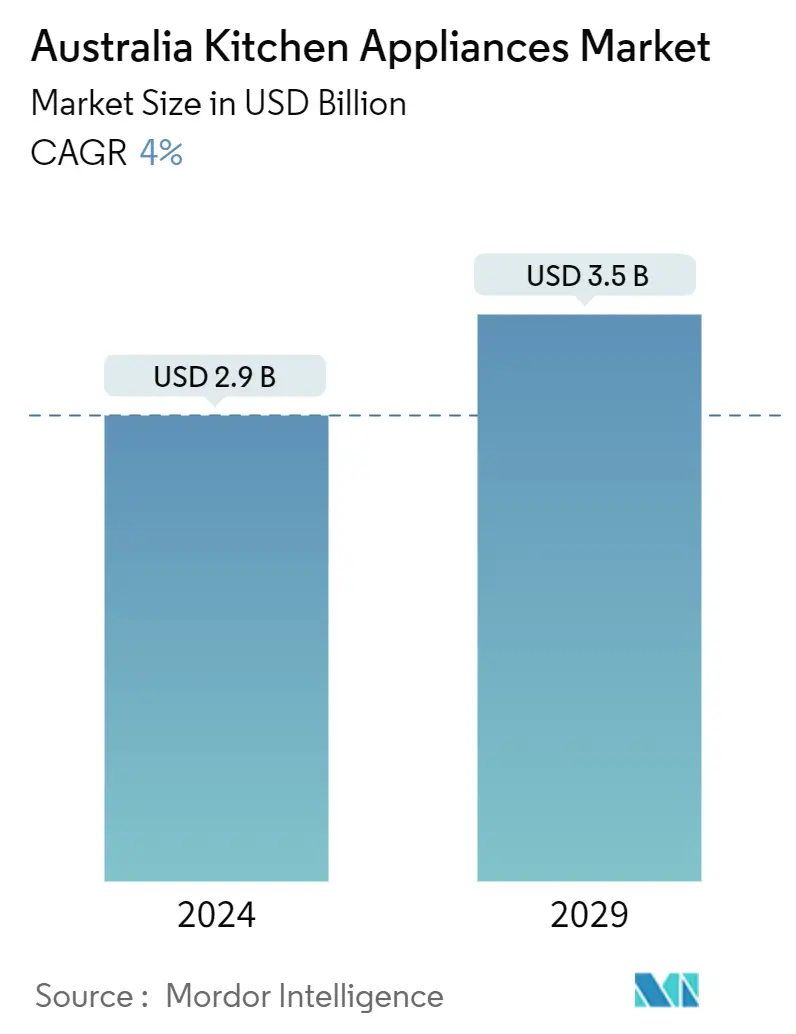
| Study Period | 2020 - 2029 |
| Base Year For Estimation | 2023 |
| Market Size (2024) | USD 2.9 Billion |
| Market Size (2029) | USD 3.5 Billion |
| CAGR (2024 - 2029) | 4.00 % |
| Market Concentration | Low |
Major Players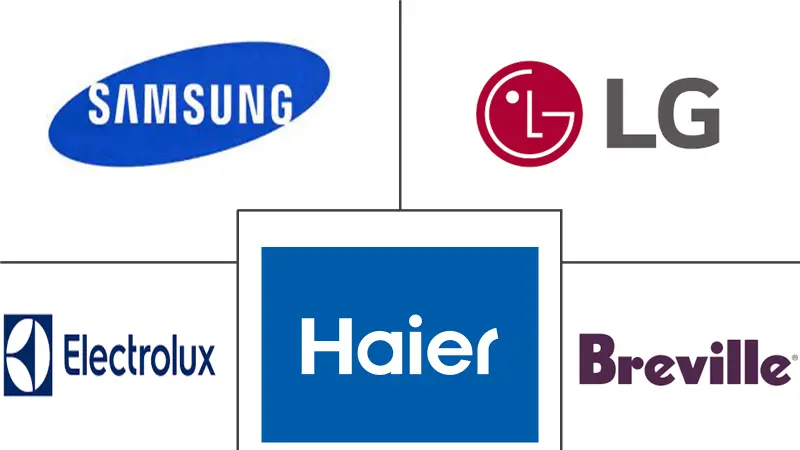
*Disclaimer: Major Players sorted in no particular order |
Australia Kitchen Appliances Market Analysis
The Australia Kitchen Appliances Market size is estimated at USD 2.9 billion in 2024, and is expected to reach USD 3.5 billion by 2029, growing at a CAGR of 4% during the forecast period (2024-2029).
The kitchen appliances market in Australia is significant and continues to grow. Factors like urbanization, a growing population, and an increasing focus on home cooking fuel the demand for modern and convenient kitchen appliances. Moreover, busy schedules and rapid changes in lifestyle are further fueling the demand for kitchen appliances, which make life more comfortable and easier. Additionally, innovations in technology and rising investments in research and development of various electric kitchen appliances are anticipated to drive the growth of the Australian kitchen appliances market during the forecast period. There is also rapid change in the way consumers shop for kitchen appliances. Residential building construction is forecast to increase over the period, supporting industry growth. In addition, household incomes are projected to rise over the next five years, with consumer sentiment remaining positive.
During the initial stage of COVID-19, the market experienced losses due to stoppages in manufacturing and distribution services caused by supply chain disruptions. Later, due to lockdowns and the work-from-home culture, the demand for kitchen appliances rose. Post-COVID, the market is experiencing gradual growth according to seasonal demand fluctuations.
Australian consumers prioritize convenience, energy efficiency, and aesthetics when it comes to kitchen appliances. Products that are easy to use, energy-efficient, and visually appealing perform well in the market. Energy-efficient appliances are highly sought after in Australia due to rising energy costs and a growing awareness of environmental concerns. Appliances with high energy efficiency ratings are popular among consumers. Health-conscious consumers are driving the demand for appliances that support healthy cooking and eating habits. Products like air fryers, steam ovens, and blenders for making smoothies are popular. Kitchen appliances are sold through various retail channels, including brick-and-mortar stores, department stores, specialty appliance retailers, and online platforms. Online sales gained traction, particularly for small appliances.
Australia Kitchen Appliances Market Trends
Small Kitchen Appliances, Coffee Machines, Microwave Ovens are High on Demand
Australians are leading busier lives. The convenience of small kitchen appliances such as microwave ovens and coffee machines became essential in their daily routines. These appliances save time and make meal preparation more efficient. Australia holds a strong coffee culture, with a preference for specialty coffee. The demand for coffee machines, especially espresso machines, reflects the desire for café-quality coffee at home. Australia includes a significant urban population. In urban areas, kitchen space can be limited, and small kitchen appliances are ideal for maximizing functionality in smaller kitchens. Many consumers in Australia are environmentally conscious and seek energy-efficient appliances. Manufacturers are responding by producing eco-friendly and energy-efficient small kitchen appliances.
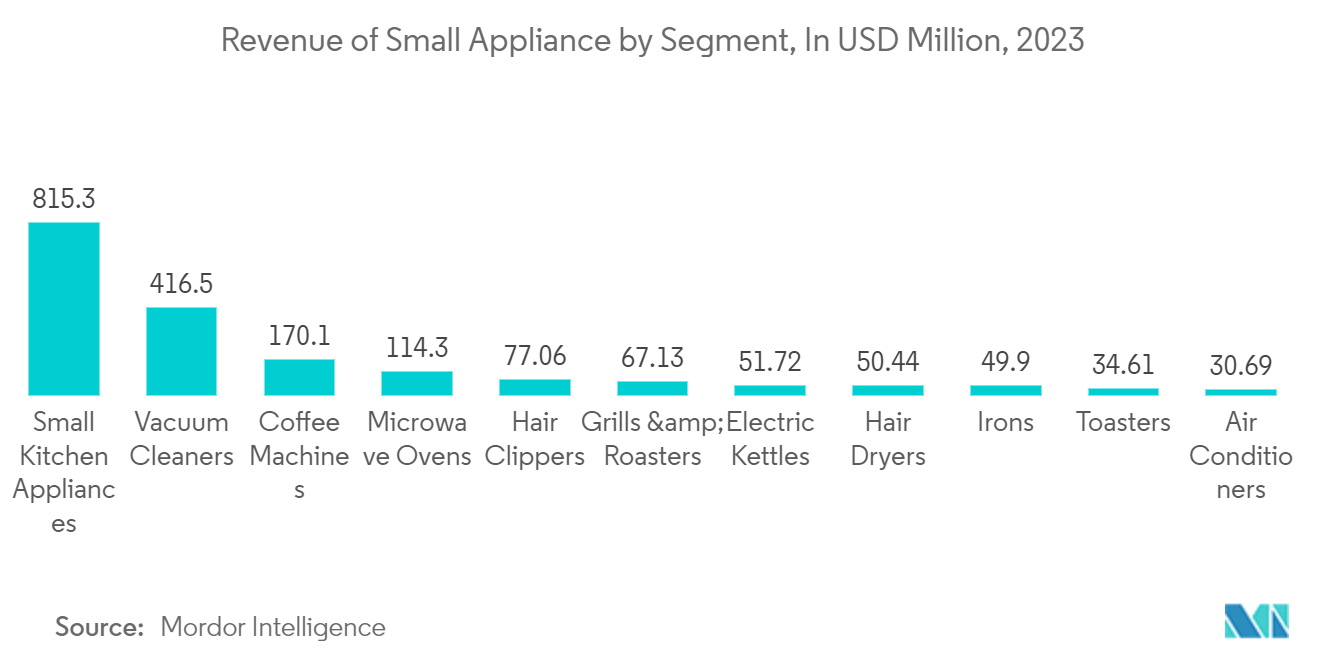
Refrigerator Occupies Highest Ownership Rate in Kitchen Appliance Market
Refrigerators are considered essential kitchen appliances, and nearly every household in Australia owns one. They are indispensable for food storage and preservation, ensuring that perishable items remain fresh and safe to consume. Refrigerators are built to last, and many consumers use the same refrigerator for a decade or longer. Their durability and long lifespan make them a valuable investment. Australian consumers appreciate the technological advancements in refrigerators, such as energy-saving modes, smart connectivity, and features like ice and water dispensers. These features enhance the usability and appeal of the appliance. The trend of cooking and eating at home, particularly during the COVID-19 pandemic, led to increased reliance on kitchen appliances, including refrigerators, to store ingredients and prepared meals. Some refrigerators come with innovative features like multiple cooling zones, adjustable shelving, and specialized compartments for different types of food. These features add to the appliance's functionality.
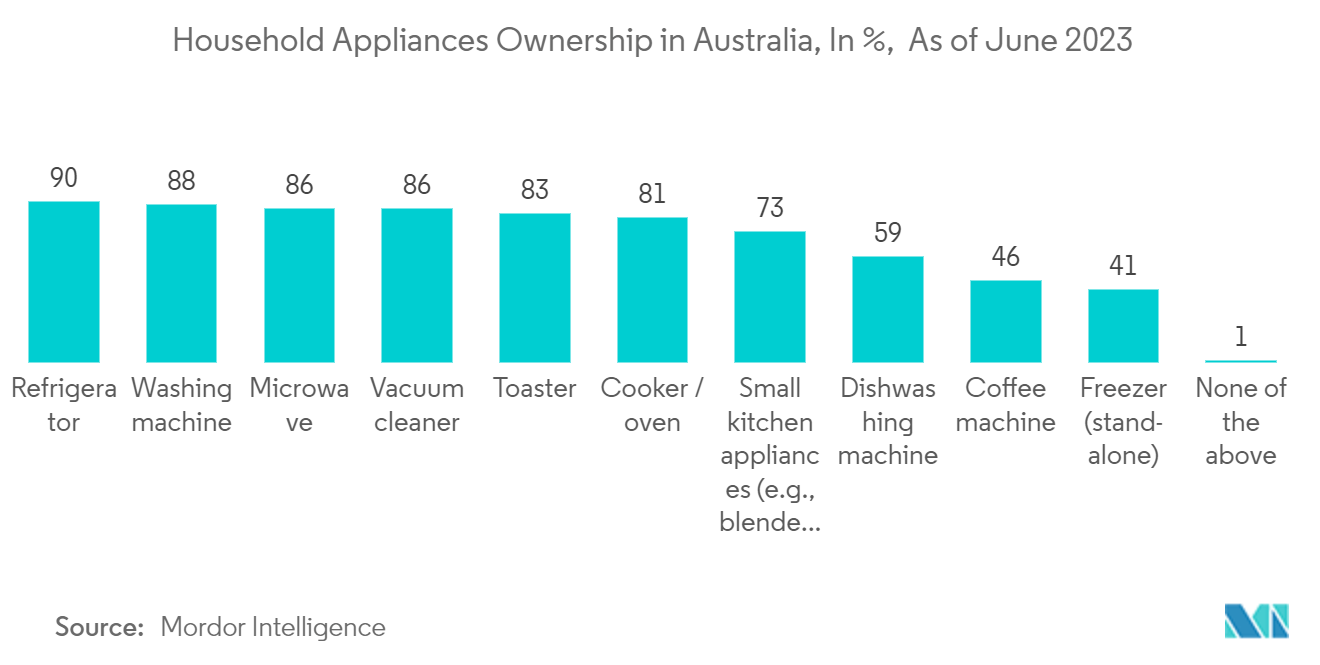
Australia Kitchen Appliances Industry Overview
The Australian Kitchen Appliances industry is fragmented, with many players operating in the market. Many international players hold a presence in the kitchen appliance market in Australia. Australia includes some local manufacturers and brands that cater to the domestic market. These brands often focus on producing high-quality products and can be competitive in terms of price and local support. Price is a significant factor in consumers' decisions. Brands that offer competitive pricing, financing options, or promotions can attract price-conscious shoppers. Major players include Samsung Electronics, Electrolux, LG Electronics, Haier Group, Miele, Breville Group, Smeg, Artusi Appliances, ILVE, and Westinghouse. Samsung is the market leader in the kitchen appliance industry in Australia.
Australia Kitchen Appliances Market Leaders
-
Samsung Electronics
-
Electrolux
-
LG Electronics
-
Haier Group
-
Breville Group
*Disclaimer: Major Players sorted in no particular order
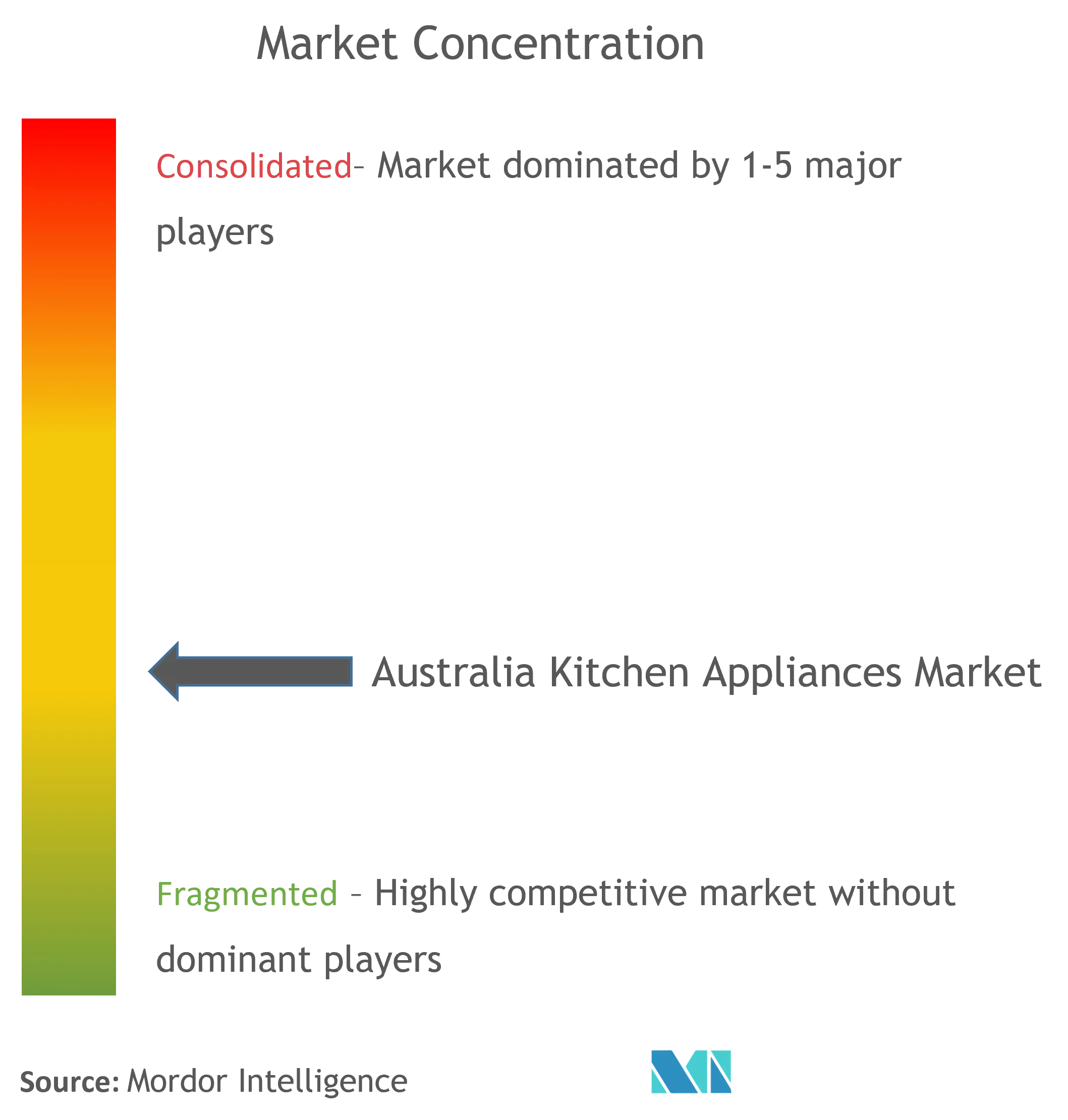
Australia Kitchen Appliances Market News
- October 2023: Kitchen appliances brand Breville is launched into the carbonated beverages category, with the release of its cutting-edge InFizz range via creative agency the General Store. Showcasing two new products, the InFizz Fusion and the InFizz Aqua, the range is an innovative way for consumers to unleash their creativity this summer. The InFizz Fusion features a pressure control system, the FusionCap, which can carbonate flavored drinks without the risk of overflow or the need to add sparkling water to existing mixes.
- April 2023: The ATP Tour partnered with home appliances and consumer electronics company Haier. The deal sees the Chinese company become the official home appliances partner and gold partner of the Tour.
Australia Kitchen Appliances Market Report - Table of Contents
1. INTRODUCTION
- 1.1 Study Assumptions and Market Definition
- 1.2 Scope of the Study
2. RESEARCH METHODOLOGY
3. EXECUTIVE SUMMARY
4. MARKET INSIGHTS AND DYNAMICS
- 4.1 Market Overview
-
4.2 Market Drivers
- 4.2.1 Renovation and Home Improvement Drives the Market
- 4.2.2 Consumer Preferences for Convenience is Driving the Market
-
4.3 Market Restraints
- 4.3.1 Changing Cultural Preferences are Challenging the Market
- 4.3.2 Price Sensitivity is Hindering the Market Growth
-
4.4 Market Opportunities
- 4.4.1 Smart Kitchen Appliances Provides Opportunities for the Market
- 4.4.2 New Cooking Technology is Encouraging the Demand for Kitchen Appliances
- 4.5 Industry Value Chain Analysis
-
4.6 Industry Attractiveness - Porter's Five Forces Analysis
- 4.6.1 Bargaining Power of Suppliers
- 4.6.2 Bargaining Power of Buyers
- 4.6.3 Threat of New Entrants
- 4.6.4 Threat of Substitutes
- 4.6.5 Intensity of Competitive Rivalry
- 4.7 Insights On Technology Innovation In The Market
- 4.8 Impact of COVID-19 on the Market
5. MARKET SEGMENTATION
-
5.1 By Product Type
- 5.1.1 Small Kitchen Appliances
- 5.1.1.1 Food Processors
- 5.1.1.2 Mixers and Grinders
- 5.1.1.3 Grills and Toasters
- 5.1.1.4 Coffee/Tea Makers
- 5.1.1.5 Cookers
- 5.1.1.6 Other Small Kitchen Appliances (Bread Makers, Air Fryers, etc.)
- 5.1.2 Large Kitchen Appliances
- 5.1.2.1 Refrigerators and Freezers
- 5.1.2.2 Ovens
- 5.1.2.3 Dishwashers
- 5.1.2.4 Other Large Kitchen Appliances
-
5.2 By End User
- 5.2.1 Residential
- 5.2.2 Commercial
-
5.3 By Distribution Channel
- 5.3.1 Multi-brand Stores
- 5.3.2 Exclusive Brand Outlets
- 5.3.3 Online
- 5.3.4 Other Distribution Channels
6. COMPETITIVE LANDSCAPE
- 6.1 Market Concentration Overview
-
6.2 Company Profiles
- 6.2.1 Samsung Electronics
- 6.2.2 LG Electronics
- 6.2.3 Breville Group
- 6.2.4 ILVE
- 6.2.5 Westinghouse
- 6.2.6 Haier Group
- 6.2.7 Electrolux
- 6.2.8 Miele
- 6.2.9 Artusi Appliances
- 6.2.10 Smeg*
- *List Not Exhaustive
7. FUTURE OF THE MARKET
8. DISCLAIMER AND ABOUT US
** Subject To AvailablityAustralia Kitchen Appliances Industry Segmentation
Kitchen appliances, such as refrigerators, stoves, dishwashers, washing machines, tumble dryers, and microwave ovens, are generally found in consumers' kitchens. A complete background analysis of the Australian kitchen appliances market, which includes an assessment of the economy, market overview, market size estimation for key segments, emerging trends in the market, market dynamics, vital competitive profiles, and the impact of COVID-19, are covered in the report. Large kitchen appliances, small kitchen appliances, end users, and distribution channels segment the market. By large kitchen appliances, the market is segmented into refrigerators and freezers, ovens, dishwashers, and other large kitchen appliances. By small kitchen appliances, the market is segmented into food processors, mixers and grinders, grills and toasters, coffee/tea makers, cookers, and other small kitchen appliances (bread makers, air fryers, etc.). By end user, the market is segmented into residential and commercial. By distribution channel, the market is segmented into multi-brand stores, exclusive stores, online channels, and other distribution channels. The market size is provided in terms of value (USD) during the forecast period for all the above segments.
| By Product Type | Small Kitchen Appliances | Food Processors |
| Mixers and Grinders | ||
| Grills and Toasters | ||
| Coffee/Tea Makers | ||
| Cookers | ||
| Other Small Kitchen Appliances (Bread Makers, Air Fryers, etc.) | ||
| By Product Type | Large Kitchen Appliances | Refrigerators and Freezers |
| Ovens | ||
| Dishwashers | ||
| Other Large Kitchen Appliances | ||
| By End User | Residential | |
| Commercial | ||
| By Distribution Channel | Multi-brand Stores | |
| Exclusive Brand Outlets | ||
| Online | ||
| Other Distribution Channels |
Australia Kitchen Appliances Market Research Faqs
How big is the Australia Kitchen Appliances Market?
The Australia Kitchen Appliances Market size is expected to reach USD 2.9 billion in 2024 and grow at a CAGR of 4% to reach USD 3.5 billion by 2029.
What is the current Australia Kitchen Appliances Market size?
In 2024, the Australia Kitchen Appliances Market size is expected to reach USD 2.9 billion.
Who are the key players in Australia Kitchen Appliances Market?
Samsung Electronics, Electrolux, LG Electronics, Haier Group and Breville Group are the major companies operating in the Australia Kitchen Appliances Market.
What years does this Australia Kitchen Appliances Market cover, and what was the market size in 2023?
In 2023, the Australia Kitchen Appliances Market size was estimated at USD 2.78 billion. The report covers the Australia Kitchen Appliances Market historical market size for years: 2020, 2021, 2022 and 2023. The report also forecasts the Australia Kitchen Appliances Market size for years: 2024, 2025, 2026, 2027, 2028 and 2029.
Australia Kitchen Appliances Industry Report
Statistics for the 2024 Australian Kitchen Appliances market share, size and revenue growth rate, created by Mordor Intelligence™ Industry Reports. Australian Kitchen Appliances analysis includes a market forecast outlook to 2029 and historical overview. Get a sample of this industry analysis as a free report PDF download.



